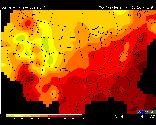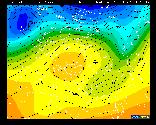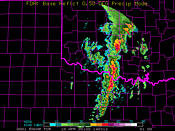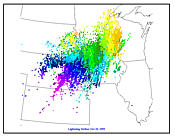One of the most attractive features of the IDD system is the ease with which new and different data products from different sources can be incorporated. While the raw data are delivered by the IDD in various digital forms which depend on the data type, graphical depictions of some of the different types generated at Unidata sites are shown here for purposes of illustration. For more complete descriptions of the data streams, see Information on Data and Data Streams.

|
Conventional Weather ReportsWeather stations around the world report atmospheric temperature, pressure, winds, cloud cover, visibility, special weather conditions, and other observations. These data are collected on a regular basis and made available by the National Weather Service (NWS) via NOAAPORT. NOAAport data products are injected into the IDD from a number of sites that have NOAAport downlink systems. These sites provide redundancy for one another. |

|
Output from Supercomputer Forecast ModelsIn addition to the observations of surface and upper-air conditions, the NWS Family of Services contains the output of a variety forecast models run on supercomputers at the National Centers for Environmental Prediction (NCEP, formerly known as the National Meteorological Center) and the European Center for Medium Range Weather Forecasting. These data products are also disseminated via NOAAPORT. Output from certain experimental models is via NWS using IDD technology as part of the Cooperative Opportunity for NCEP Data Using IDD Technology (CONDUIT) project. |

|
Satellite ImageryUnidata has a tailored set of data products prepared at the Space Science and Engineering Center (SSEC ) at the University of Wisconsin, Madison. These data are disseminated on what is called the Unidata/Wisconsin, or McIDAS, channel. One special feature of this data stream is satellite imagery. Most of the images are from Geostationary Orbiting Environmental Satellites (GOES), but certain data from other satellite observing platforms can be injected on request. Currently SSEC is the IDD injection point for all satellite imagery. |

|
Radar Data Data products from NEXRAD radar systems is now distributed via NOAAPORT and the IDD. These Level III processed radar images were formerly only available through commercial provider. In addition, project CRAFT (Collaborative Radar Acquisition Field Test) is using IDD technology to disseminate Level II three-dimensional full volume scan radar data from the NEXRAD sites. |

|
Lightning Strike DataMany Unidata universities are interested in lightning data. Unlike other sources of weather-related data, the National Lightning Detection Network (NLDN) is owned and operated entirely by a private company, Global Atmospherics, Inc., of Tucson, Arizona. However, the State University of New York at Albany (SUNYA) has arranged with Global Atmospherics to deliver data from the NLDN to several interested universities for education and research purposes. More detailed information on lightning data can be found in Lightning Data Available on the Internet. |
 |
Experimental Data ProductsThese include Aircraft Communications Addressing and Reporting System (ACARS) data, and six-minute and hourly summaries of profiler data from the Forecast Systems Laboratory. Additional data sets are available from Fleet Numerical Meteorology and Oceanography Center, e.g., NOGAPS and COAMPS. One of the main advantages of the IDD approach is that universities can use the technology to move data from one site to another without any central coordination. As one example of this, the University of Michigan is using LDM/IDD technology to create mirror servers for the suite of electronic weather maps it generates each hour. This provides several access points for the many K-12 schools that use the weather maps in their classrooms. |